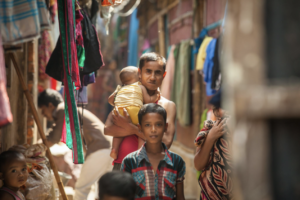Global efforts to eliminate TB have been set back by the COVID-19 pandemic.
Health Policy Watch
Aishwarya Tendolkar
01/10/2021
Key messages (by the Editor of the blog)
TB kills 4,000 people a day (~1,5 million/year)
- The airborne disease still kills 4,000 people every day, with nearly a quarter of the world’s population estimated to have been infected.
- In Brazil Tuberculosis killed 6.700 in the year of 2019 (Stop TB Partnership)
- Despite being curable and preventable, only an estimated 5.7 million people received treatment for TB in 2020, a decline of 21 percent from the previous year–
- leaving an estimated 4.3 million people with untreated TB and implying all but certain death for probably half that number, the report showed.
The COVID-19 pandemic and the consequent diversion of resources toward battling SARS-CoV2 has also set back global efforts to eliminate the world’s second most deadly infectious killer: Tuberculosis, by 2030.
- COVID’s impact on TB response this year continues to be as devastating as last year, with 1.2 million fewer people projected to be diagnosed and treated for TB this year, in comparison with 2019.
Only a doubling of investments next year can pave the way to attainment of the 2030 United Nations Sustainable Development Goals to eliminate the disease (from US$ 6,5 billion to US$ 13,0 billion)
Less reliable sputum smear microscopy remains the dominant diagnostic tool for TB (28%), despite the existence of highly accurate rapid molecular assays.
FULL VERSION
The COVID-19 pandemic and the consequent diversion of resources toward battling SARS-CoV2 has also set back global efforts to eliminate the world’s second most deadly infectious killer: Tuberculosis, by 2030.
Only a doubling of investments next year can pave the way to attainment of the 2030 United Nations Sustainable Development Goals to eliminate the disease, experts and panelists at the Stop TB Partnership said Tuesday.
The panel session coincided with the release of new data from a study conducted by the Stop TB Partnership that showed COVID’s impact on TB response this year continues to be as devastating as last year, with 1.2 million fewer people projected to be diagnosed and treated for TB this year, in comparison with 2019.
The new estimates, developed in collaboration with USAID, Johns Hopkins University, Avenir Health and Imperial College, are based on data from 27 countries that account for 75 percent of the global TB caseload.
That means TB investments for this coming year need to be doubled, in order to meet a 2018–2022 target for diagnosing and treating 40 million people (or 10 million a year), within that four year time frame, the Partnership says.
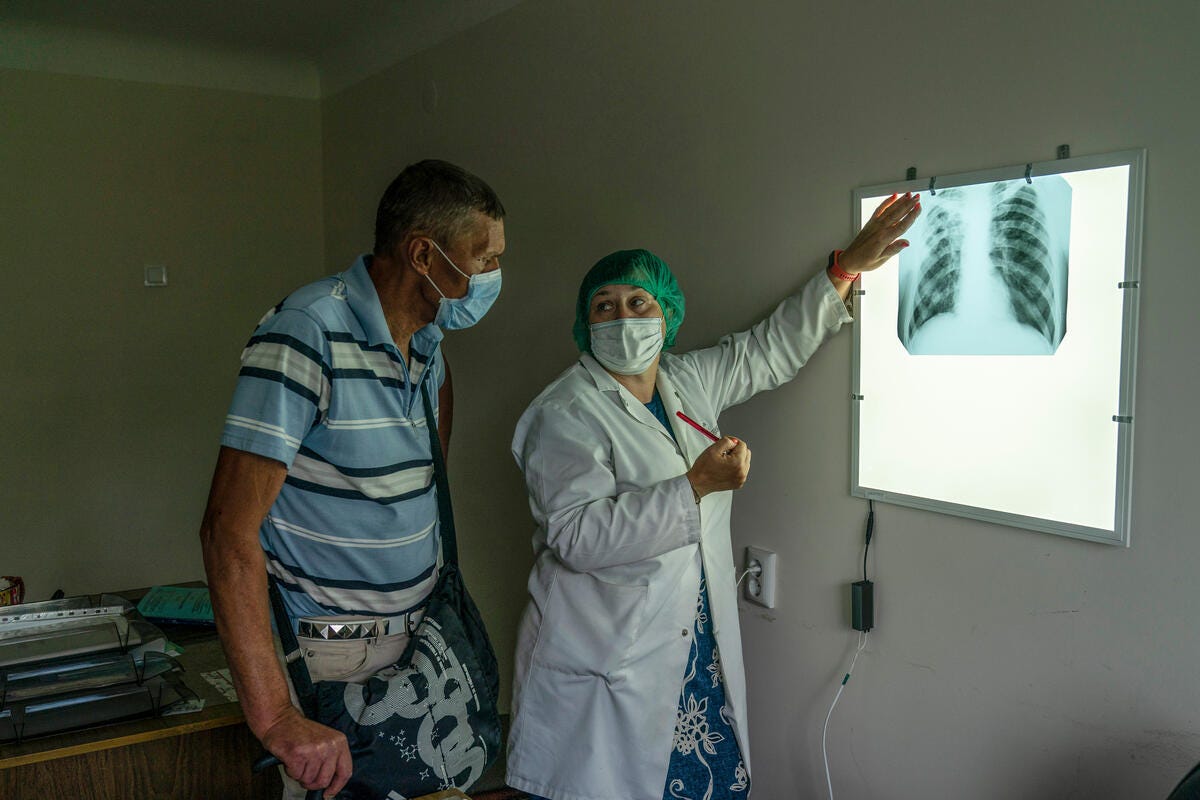
TB kills 4,000 people a day (~1,5 million/year)
- The airborne disease still kills 4,000 people every day, with nearly a quarter of the world’s population estimated to have been infected.
- Despite being curable and preventable, only an estimated 5.7 million people received treatment for TB in 2020, a decline of 21 percent from the previous year–
- leaving an estimated 4.3 million people with untreated TB and implying all but certain death for probably half that number, the report showed.
A lack of attention to the disease, lack of funding, and a dearth of proper diagnostic tools are responsible, Dr. Lucica Ditiu, Executive Director of the Stop TB Partnership said at a Stop TB briefing Tuesday.
“COVID showed that if the government and people are scared, money is not an issue. We are in the middle of a disaster but our attention seems to be in a very wrong place.”
A lack of attention to the disease, lack of funding, and a dearth of proper diagnostic tools are responsible …

Dr. Lucica Ditiu, Executive Director of the Stop TB Partnership.
The “orphan disease” does not receive political priority or funding, Obiefuna Austin Arinze, Executive Director of Afro Global Alliance and incoming Vice-Chair of the Stop TB Partnership Board said.
At current levels of funding, the world will miss the target set by the United National High-Level Meeting on TB that took place in 2018 for diagnosing and treating 40 million people with TB by 2022.
With just 400 days to reach 2022 goals, the diagnostic figure is even more grim for children with TB, Ditiu said.
However, with mobilisation of resources — including funding, digital diagnostics and more government-sponsored community interventions — the world could reach the target’s 90% mark — treating some 36 million people, Ditiu said.
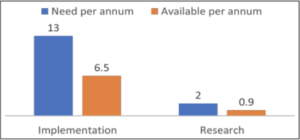
So why is investing in TB diagnosis and elimination imperative?
In simple words, it saves more lives than you would think. “Investing an extra dollar in TB is one of the best dollars spent to help the world,” Dr Bjorn Lomborg, President of the Danish think tank, Copenhagen Consensus, said at the teleconference.
- According to him, it would only cost US$8.1 billion dollars annually, between now and 2030, to eliminate TB.
- This investment translates to benefits worth US$348 billion dollars, pegging the benefit-cost ratio at 43. This means that every dollar invested in TB prevention and care yields a return of US$43.
- But currently, only US$6.5 billion is available annually for TB response globally. Moreover, TB funding has stagnated over the last five years — meaning there are big gaps that need to be overcome now.
That’s why, a t the UNHLM on TB in 2018, states and non-state actors pledged to commit a total of US$13 billion annually until 2022 to overcome past shortfalls — unfortunately COVID intervened the following year and those pledges were not honored.
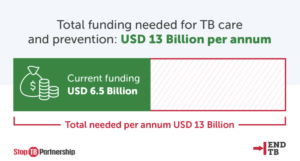
TB is traditionally a low GF funding priority — despite a high dependency on Global Fund services in LMICs
Despite being curable, preventable, and easily diagnosable, TB sees more deaths (over 1 million annually) than HIV/AIDS and Malaria combined.
At the same time, The Global Fund channels only 18 percent of its resources to TB diagnosis and treatment. The remaining 82% is invested in fighting HIV/AIDS, malaria, and more recently, COVID-19 tests and treatments.
Although 85% of national TB budgets, on average, are financed by low- and middle-income countries themselves, they remain highly dependent on the Global Fund to Fight AIDS, Tuberculosis, and Malaria to fill vital gaps in services. And that adds weight to the Global Fund’s appeals, panelists pointed out.
In terms of how those funds should be spent, the World Health Organisation along with the UN Secretary General have outlined priority recommendations to ramp up the TB response, Tereza Kasaeva, Director of WHO’s Global TB Programme said. “Efforts need to be intensified to make these recommendations a reality.”
Diagnosis still reliant on less accurate sputum smear microscopy
According to , the diagnosis of TB and drug-resistant TB remains a challenge with one-third of people with TB and two-thirds of people with drug-resistant TB not being detected globally.
While WHO recommends highly accurate rapid molecular assays as the initial test to diagnose TB, less reliable sputum smear microscopy remains the dominant diagnostic tool.
- Only 28 percent of people were diagnosed with MTB using a rapid molecular test in 2019, Ditiu said.
- This means that nearly three quarters of diagnoses are done using the “clinical” smear microscopy. Smear microscopy, while cost-effective, has a poor track record in diagnosing extra-pulmonary tuberculosis, paediatric tuberculosis, and TB in patients co-infected with HIV and tuberculosis, a paper pointed.
“Why don’t we allow people proper diagnostic tools?” she asked, pointing out that
an untreated person with TB can transmit the bacteria to nearly 15 people every year. “Now think about this in countries like India with a population of 1.2 billion.”
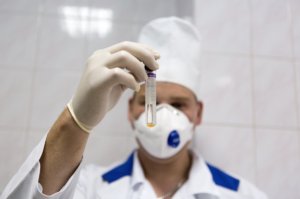
Less reliable sputum smear microscopy remains the dominant diagnostic tool for TB, despite the existence of highly accurate rapid molecular assays.
COVID devastated TB diagnostics
To make matters worse, the COVID-19 pandemic devastated the diagnostics investments in TB — whereby existing resources were diverted, and tools like the highly accurate GeneXpert molecular diagnostic platforms were repurposed to diagnose COVID, in the pandemic’s early days.
Since then, new rapid COVID diagnostic tests have become widely available, but there has been no significant recovery plan for TB diagnostics put into place, Obiefuna said.
The COVID-19 pandemic was not the first time that the health infrastructure for TB was used to tackle other health crises, and particularly those related to airborne diseases, pointed out Cheri Vincent, Chief of USAID’s TB Division, at the meeting.
“We saw it [being diverted] for Ebola and airborne influenza,” she said, adding, “If we can’t solve TB, we can’t solve the next airborne pandemic,” she highlighted.
In fact, TB doctors were the first to be diverted to tackle the COVID-19 breakout, Ditiu said.
The Zambia story, and what it teaches us
But not all has been downhill in the fight against TB.
Zambia offers an example of a country that has been able to sustain its TB programmes through a combination of domestic funding, government-community partnerships, and diagnostic tools — despite the COVID pandemic. It can provide inspiration for countries battling both diseases at the same time.
Already today, Zambia has achieved 89% of its 2022 UNHLM diagnosis and treatment target. Over the past five years, the country invested US$45 million of domestic resources in TB response. “[TB] commodity security is key to achieving our goals,” said Dr. Patrick Lungu, National TB and Leprosy Control Program Manager in Zambia.
A ‘TB Situation room’ was created to review TB programmes on a weekly basis to identify issues that may be negatively impacting performance.
“We were able to offer more technical support to different levels of the health system — which translates to Zambia envisaging to achieve the UNHLM target in at least two-three key indicators,” Lungu said.
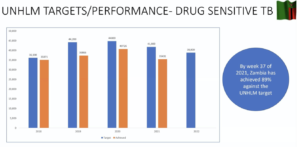
Zambia has achieved nearly 89 percent of its UNHLM target so far.
Will India achieve its ambitious 2025 TB elimination target?
When it comes to countries like India — which bears the heaviest TB burden in the world, the pandemic has slowed-down and diverted efforts to eliminate elimination of TB by 2025 -a huge goal set by the government.
According to the Indian Health Ministry’s 2021 Annual Report on Tuberculosis Elimination, reports and notification of confirmed TB diagnoses tumbled 38 percent in March-April 2020 owing to the lockdown.
Furthermore, a majority of the country’s TB elimination resources were repurposed for Covid-19. Then just as services were beginning to recoup, a massive second COVID wave hit the country in spring 2021; it remains unclear what dents that made in the progress India had seen toward the end of 2020.
In its 2021 official report, the Indian Health Ministry nonetheless suggested that the dedicated Infectious disease hospitals that were established for Covid will contribute “significantly” to future TB Care and management.
Despite being scheduled to be a part of Tuesday’s Stop TB Partnership panel, the Indian Health Ministry did not make an appearance — leaving a lack of clarity on trends and progress in 2021.
But on a global level, the warning signs are clear.
Says Ditui: “we have erased 10–12 years of progress, and are back to 2010–11 levels of TB detection and cases. This becomes all the more alarming with the fact that TB is not a new disease but one that has been around for decades, and has a vaccine. One can only hope that TB receives the undivided effort it needs to be eliminated.”
Image Credits: The Global Fund / Evgeny Maloletka, Stop TB Partnership, Dr. Patrick Lungu.
Originally published at https://healthpolicy-watch.org.
Names mentioned:
Dr. Lucica Ditiu, Executive Director of the Stop TB Partnership;
Obiefuna Austin Arinze, Executive Director of Afro Global Alliance and incoming Vice-Chair of the Stop TB Partnership Board;
Dr Bjorn Lomborg, President of the Danish think tank, Copenhagen Consensus;
Cheri Vincent, Chief of USAID’s TB Division.
Statistics for Brasil (Stop TB Partnership)





